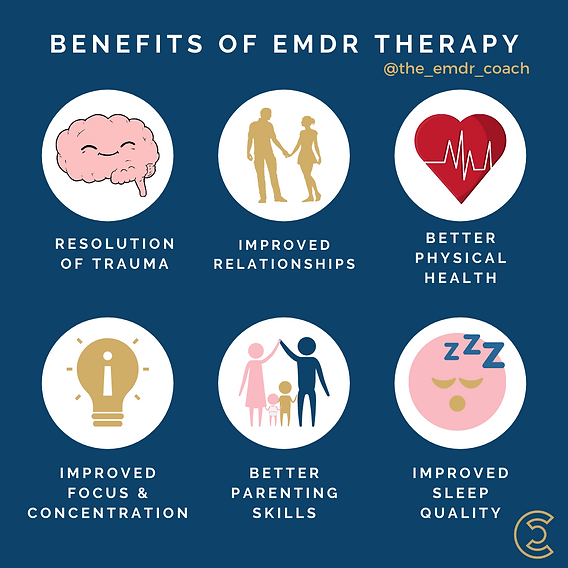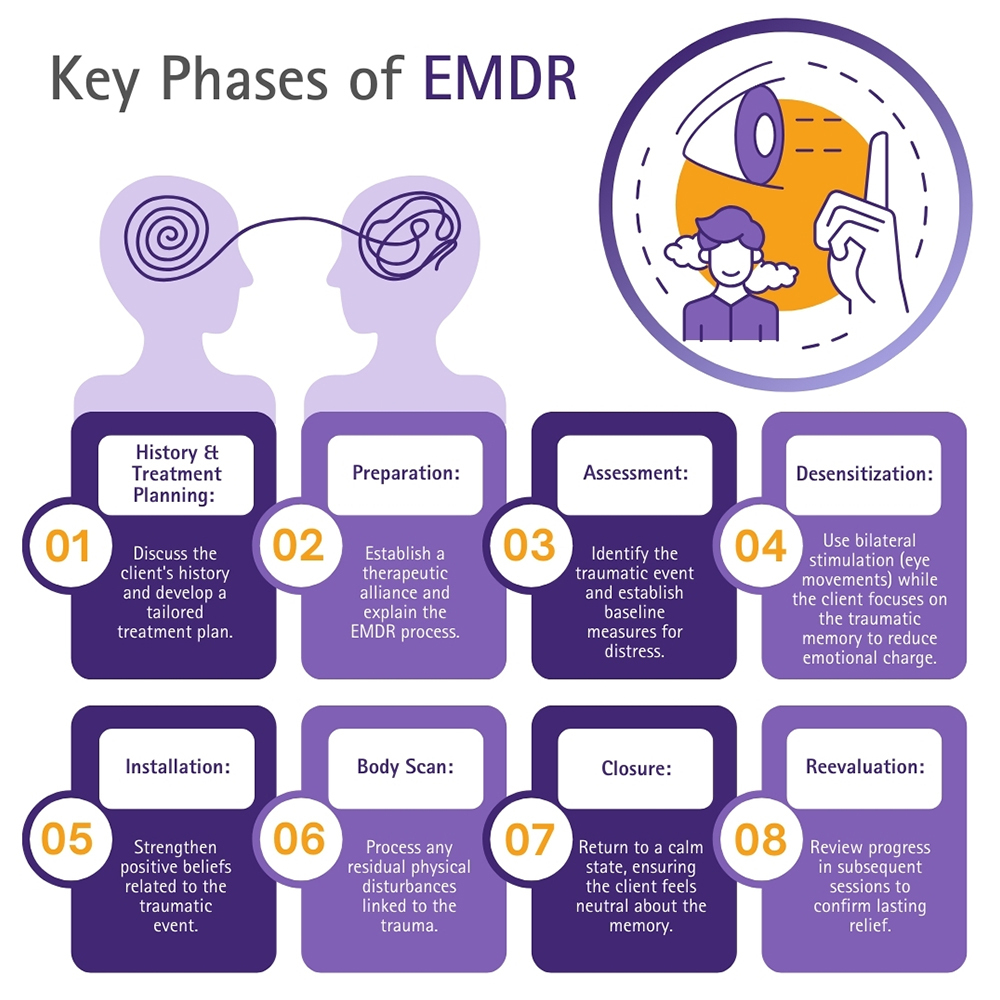How emdr therapy new york city handles trauma with organized approaches
Just How EMDR Therapy Works: a Detailed Take A Look At the Refine and Its Efficiency
EMDR therapy has arised as a famous treatment for trauma-related disorders. Its organized technique includes various stages created to assist in the processing of traumatic memories. Central to this approach is the idea of bilateral excitement, which plays a necessary duty in just how memories are processed. Understanding these components exposes much about the treatment's efficiency. What particularly occurs throughout an EMDR session, and how does it influence the restorative trip?
Comprehending the Concepts of EMDR Therapy
EMDR treatment, or Eye Motion Desensitization and Reprocessing, operates on the facility that unsettled terrible experiences can prevent psychological wellness. This cutting-edge restorative strategy aims to promote the processing of stressful memories, allowing people to acquire a much healthier perspective on their past. Central to EMDR is the idea of reciprocal stimulation, commonly achieved with led eye motions, which is thought to aid integrate stressful memories into a much more flexible structure.

The 8 Stages of EMDR Treatment
The process of EMDR therapy unravels over 8 distinctive phases, each designed to guide customers with a structured strategy to recovery injury. The first stage includes history-taking, where the therapist analyzes the customer's background and identifies target memories. In the 2nd phase, clients find out leisure techniques to take care of distress. The 3rd phase concentrates on determining adverse ideas connected with the distressing memory.
The fourth stage is where the desensitization process begins, permitting clients to refine the distressing memory. The fifth stage entails installing favorable ideas to replace the adverse ones. In the 6th stage, customers are led to assess their physical and psychological feedbacks to the processed memory. The 7th phase stresses closure, assisting customers return to a state of stability. The eighth stage involves reevaluation, where clients and therapists assess progress and attend to any residual distress. This thorough technique cultivates a pathway to healing and strength.
The Role of Bilateral Excitement
Reciprocal stimulation is a necessary component of EMDR therapy, promoting the processing of distressing memories. This strategy entails alternating stimulation of both hemispheres of the mind, generally accomplished via eye movements, auditory tones, or tactile feelings. The objective of reciprocal excitement is to engage the brain's natural information processing system, which may end up being interfered with adhering to trauma.
By activating both sides of the brain, bilateral stimulation assists clients gain access to and recycle stressful memories in an extra flexible means. This strategy encourages the integration of terrible experiences, minimizing their psychological fee and allowing customers to establish new point of views.

In useful content addition, reciprocal stimulation may advertise leisure and decrease anxiety throughout sessions, producing a much safer environment for customers to challenge agonizing memories. Eventually, this approach improves the therapeutic procedure, enabling individuals to approach healing and resolution.
Proof Supporting the Effectiveness of EMDR
Research study has actually revealed that EMDR therapy works in dealing with various psychological problems, especially trauma (PTSD) Many researches have actually shown considerable reductions in PTSD signs and symptoms complying with EMDR therapy. A meta-analysis of randomized controlled tests found that EMDR was as efficient as cognitive behavior therapy (CBT) for PTSD, with long-term impacts observed also months after treatment. Furthermore, the American Psychological Organization and the World Wellness Organization support EMDR as an advised treatment for trauma-related problems.
Beyond PTSD, research study suggests that EMDR can additionally profit people dealing with stress and anxiety, clinical depression, and anxieties. A growing body of proof sustains its use in varied populaces, including veterans and kids - best emdr therapy in nyc. In general, the gathering research highlights EMDR's possible as a functional therapeutic choice, leading the means for more exploration into its systems and applications in psychological wellness therapy
What to Anticipate Throughout an EMDR Session
Throughout an EMDR session, customers can expect a structured yet adaptable approach focused on processing distressing memories. The specialist starts by establishing a secure setting, where customers can really feel comfy sharing their experiences. First conversations concentrate on recognizing particular memories and associated unfavorable ideas.
Clients are directed to concentrate on these memories while all at once taking part in bilateral excitement, normally with directed eye activities or touching. This twin focus intends to facilitate the handling of the trauma, permitting clients to reframe their experiences and reduce emotional distress.
Throughout the session, therapists monitor customers' actions, adjusting the pace and technique as required. Procedure might include relaxation methods or cognitive restructuring to enhance favorable ideas. In general, clients can anticipate a supportive atmosphere that motivates self-exploration and healing, inevitably resulting in a greater sense of emotional wellness.
Frequently Asked Inquiries
Is EMDR Therapy Suitable for Children or Adolescents?
EMDR treatment can be suitable for children and teenagers, provided it is adapted to their developmental needs (emdr therapy). Medical professionals frequently modify methods to ensure security and efficiency, sustaining more youthful populations in handling injury and emotional distress
Exactly How Long Does EMDR Therapy Typically Last?
EMDR treatment usually lasts in between 8 to 12 sessions, with each session ranging from 60 to 90 mins. However, private needs and the complexity of injury can impact the overall duration of treatment.
Can EMDR Therapy Be Done Remotely or Online?
EMDR treatment can get redirected here indeed be carried out from another location or online. Several professionals have adapted their methods to virtual settings, enabling clients to engage in efficient sessions from the comfort of their homes, keeping therapeutic advantages.
What Are the Possible Negative Effects of EMDR?
Possible adverse effects of EMDR therapy may consist of temporary psychological distress, enhanced anxiety, brilliant memories, and physical pain. People may likewise experience fatigue or headaches following sessions, as the mind refines extreme sensations and memories.
Exactly How Does EMDR Compare to Standard Talk Treatment?

EMDR treatment, or Eye Movement Desensitization and Reprocessing, operates on the premise that unsolved distressing experiences can prevent emotional well-being. The process of EMDR treatment unravels over eight go to website unique stages, each made to assist customers via a structured approach to healing trauma. Bilateral excitement is an important part of EMDR treatment, assisting in the processing of stressful memories. Throughout an EMDR session, clients can expect a structured yet adaptable approach aimed at processing stressful memories. Potential side results of EMDR therapy may consist of momentary emotional distress, enhanced anxiousness, brilliant memories, and physical pain.